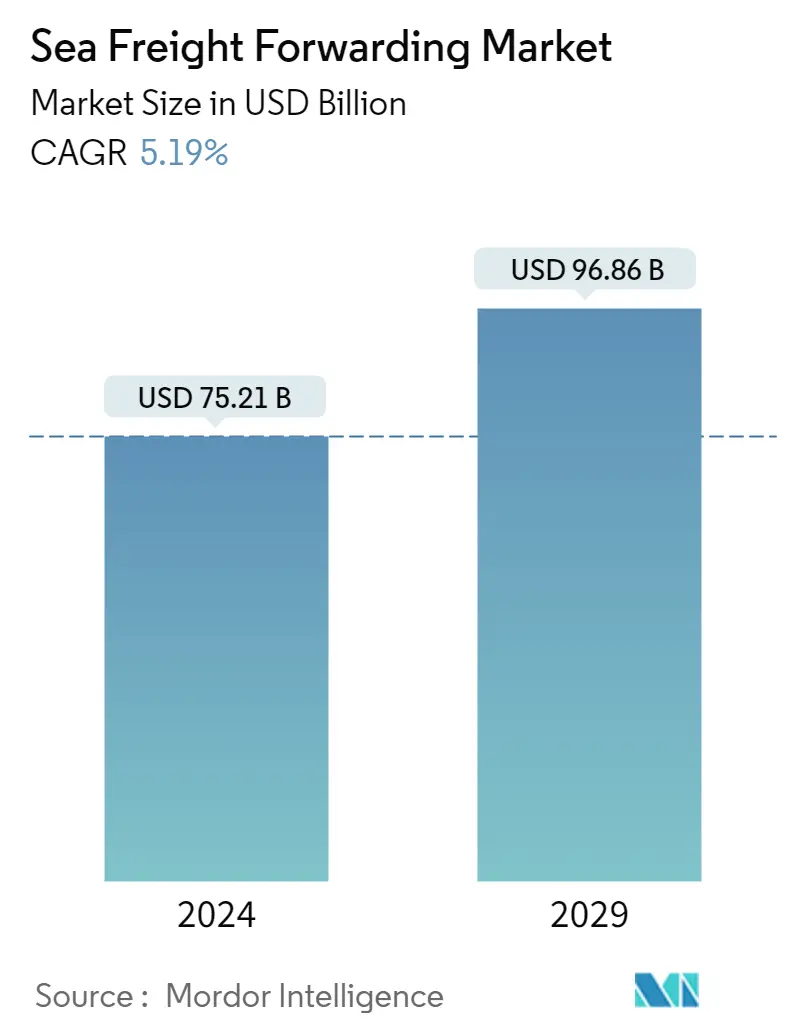Market Size of Sea Freight Forwarding Industry

| Study Period | 2020 - 2029 |
| Market Size (2024) | USD 75.21 Billion |
| Market Size (2029) | USD 96.86 Billion |
| CAGR (2024 - 2029) | 5.19 % |
| Fastest Growing Market | Asia |
| Market Concentration | Low |
Major Players
*Disclaimer: Major Players sorted in no particular order |
Sea Freight Forwarding Market Analysis
The Sea Freight Forwarding Market size is estimated at USD 75.21 billion in 2024, and is expected to reach USD 96.86 billion by 2029, growing at a CAGR of 5.19% during the forecast period (2024-2029).
- The global sea freight forwarding market is booming, owing to the growing internet penetration, increasing Purchasing Power Parity, and developments in infrastructure and services designed particularly for the e-commerce industry. The epidemic negatively impacted the shipping industry as workforces in these sectors were shut down for safety and to prevent the spread of COVID-19.
- Sea freight forwarding has emerged as a preferred mode among several end-user industries and several strategic partnerships are also likely to promote the growth of sea freight forwarding during the forecast period. The growing global cross-border e-commerce market is driving the LCL volume and is positively impacting the sea freight forwarding market growth.
- Sea freight has been an important means of transporting goods, products, and people for thousands of years. Today, ships transport vital commodities such as coal, oil and gas, supporting the global economy. In 2021 alone, about 1.5 million tonnes of coal and about 1.10 million tonnes of oil were shipped.
- More importantly, about 85% of all goods are transported by sea, mainly by container ships. Compared to other means of transport, vessels have vast capacities suitable for transporting large, heavy, and bulky items that are more economical while producing relatively small amounts of emissions.
- Shipping rates are expected to drop further for the rest of the year and into 2023, according to shipowners and analysts. With a number of new vessels entering service over the next two years, net growth in the fleet size is expected to be over 9% through 2023 to 2024. By contrast, container volume growth in 2024 could be slightly negative according to Braemer.
Sea Freight Forwarding Industry Segmentation
Global Sea Freight Forwarding is a method of transporting large quantities of goods using cargo ships where goods are packed in containers and loaded onto ships. A typical freighter can carry about 18,000 containers, making ocean freight a cost-effective way to transport large quantities over long distances.
Sea Freight Forwarding Market report provides insights on the market like Market Overview, Market Dynamics, Value Chain / Supply Chain Analysis, Technological Trends, Investment Scenarios, Government Regulations and Initiatives, Sea Freight Transportation Costs/Freight Rates, Insights on the E-commerce Industry, Impact of COVID-19 on Sea Freight Forwarding Market and Industry Attractiveness. Furthermore, the report also provides company profiles with leading market players to understand the competitive landscape of the market.
The Sea Freight Forwarding market is segmented by type (FCL, LCL, and Others) and By Geography (North America [United States, Canada, and Mexico], Europe [Germany, France, Netherlands, United Kingdom, Italy, and Rest of Europe], Asia Pacific [China, Japan, Australia, India, Singapore, Malaysia, Indonesia, South Korea, and Rest of Asia Pacific], Middle East and Africa [South Africa, Egypt, GCC Countries, Rest of Middle East, and Africa], and South America [Brazil, Chile, Rest of South America]). The report offers market size and forecasts in value (USD billion) for all the above segments.
| By Type | |
| Full Container Load (FCL) | |
| Less-than Container Load (LCL) | |
| Others |
| By Geography | |||||||||||
| |||||||||||
| |||||||||||
| |||||||||||
| |||||||||||
|
Sea Freight Forwarding Market Size Summary
The sea freight forwarding market is experiencing significant growth, driven by factors such as increased internet penetration, rising purchasing power, and advancements in infrastructure tailored for the e-commerce sector. Despite the initial setbacks caused by the COVID-19 pandemic, which disrupted workforce operations, the market has rebounded and is poised for further expansion. Sea freight forwarding has become a preferred logistics solution for various industries, with strategic partnerships enhancing its growth prospects. The burgeoning global cross-border e-commerce market is particularly influential, boosting less-than-container load (LCL) volumes and positively impacting market dynamics. Sea freight remains a crucial mode of transportation, with ships playing a vital role in the global economy by transporting essential commodities and facilitating international trade.
The market is characterized by its competitive and fragmented nature, with numerous players such as Kuehne + Nagel, DHL Supply Chain & Global Forwarding, and DB Schenker actively participating. These companies serve as intermediaries, managing logistics and shipment arrangements via common sea carriers. The industry's growth is further supported by technological advancements and the expansion of free trade, which have enhanced the efficiency and speed of shipping operations. The increasing volume of international trade conducted by sea, coupled with the environmental and cost benefits of maritime transportation, suggests a favorable outlook for the industry. Strategic acquisitions, such as Maersk's purchase of Senator International, highlight ongoing efforts to strengthen logistics capabilities and expand market reach.
Sea Freight Forwarding Market Size - Table of Contents
-
1. MARKET INSIGHTS
-
1.1 Current Market Scenario
-
1.2 Value Chain / Supply Chain Analysis
-
1.3 Technological Trends
-
1.4 Investment Scenarios
-
1.5 Government Regulations and Initiatives
-
1.6 Spotlight - Sea Freight Transportation Costs/Freight Rates
-
1.7 Insights on the E-commerce Industry
-
1.8 Impact of COVID-19 on the Sea Freight Forwarding Market
-
-
2. MARKET SEGMENTATION
-
2.1 By Type
-
2.1.1 Full Container Load (FCL)
-
2.1.2 Less-than Container Load (LCL)
-
2.1.3 Others
-
-
2.2 By Geography
-
2.2.1 North America
-
2.2.1.1 United States
-
2.2.1.2 Canada
-
2.2.1.3 Mexico
-
-
2.2.2 Europe
-
2.2.2.1 Germany
-
2.2.2.2 France
-
2.2.2.3 Netherlands
-
2.2.2.4 United Kingdom
-
2.2.2.5 Italy
-
2.2.2.6 Rest of Europe
-
-
2.2.3 Asia-Pacific
-
2.2.3.1 China
-
2.2.3.2 Japan
-
2.2.3.3 Australia
-
2.2.3.4 India
-
2.2.3.5 Singapore
-
2.2.3.6 Malaysia
-
2.2.3.7 Indonesia
-
2.2.3.8 South Korea
-
2.2.3.9 Rest of Asia-Pacific
-
-
2.2.4 Middle East & Africa
-
2.2.4.1 South Africa
-
2.2.4.2 Egypt
-
2.2.4.3 GCC Countries
-
2.2.4.4 Rest of Middle East & Africa
-
-
2.2.5 South America
-
2.2.5.1 Brazil
-
2.2.5.2 Chile
-
2.2.5.3 Rest of South America
-
-
-
Sea Freight Forwarding Market Size FAQs
How big is the Sea Freight Forwarding Market?
The Sea Freight Forwarding Market size is expected to reach USD 75.21 billion in 2024 and grow at a CAGR of 5.19% to reach USD 96.86 billion by 2029.
What is the current Sea Freight Forwarding Market size?
In 2024, the Sea Freight Forwarding Market size is expected to reach USD 75.21 billion.

